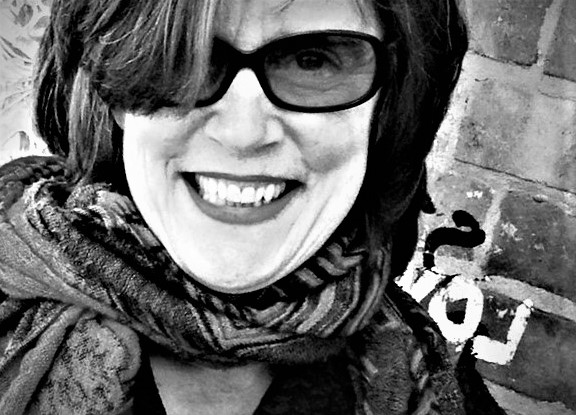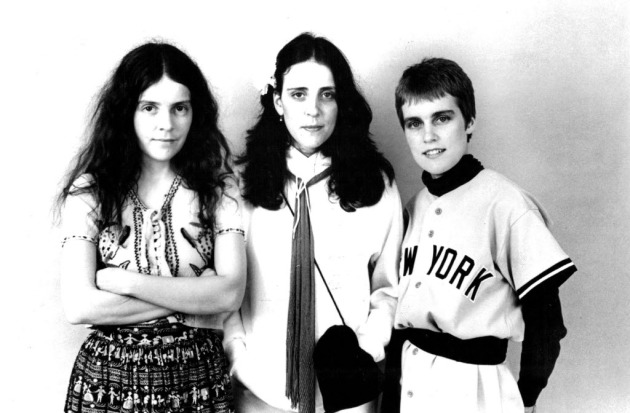The middle sister of the Roches who shrieked “Exposure” on Fripp’s album, meets up over a hot fudge sundae in Santa Monica

She’s best known as the middle sister in the group, the one in the middle between big sister Maggie and little sister Suzzy. At first they were a duo, Terre and Maggie. When Suzzy was old enough and wanted to join the became The Roches. They formed a beloved, uniquely poignant folk trio, shining always with luminous harmony vocals, and original songs of charming, eccentric beauty.
Videos by American Songwriter

Raised in Park Ridge, New Jersey, Maggie was the songwriter first, and a brilliant one from the start. Terre, two years younger, looked up to Maggie always with much reverence, not unlike George Harrison with Lennon. Maggie’s songs were so brilliantly written, with healthy doses of both brain and heart, that Terre didn’t consider writing her own at first. She loved singing Maggie’s songs, because she knew Maggie to be a genius.
Gradually, that genius rubbed off on her. Both were naturally gifted and creative harmony singers, as was Suzzy, who is three years younger than Terre. When they became a trio, they created a singularly exultant sound, with a distinctive blend of soul, sweetness and sophistication. Together those three voices harmonized to create a sound only siblings make – three individual voices connected by their foundational familial roots. The McGarrigle Sisters had that sound, as did The Everly Brothers. With The Roches it was like three separate parts of the same personality; nearly identical but with just enough difference to effect a rich, vivid presence.

Maggie and Terre took a class on songwriting Paul Simon taught at the New School in New York. It was 1970, and they were 19 and 17 respectively; Suzzy at 13 was still a kid. “Bridge Over Troubled Water” was the biggest hit in the world then, and on radio always. Simon recognized the sisters’ talent and ambition, and offered to help them.
It was when he was giving them a ride to the George
Washington Bridge – so they could take the bus to their Jersey home – that he
also helped them understand that they were good, but could be great. And to be
great – as singers, musicians, songwriters,
and recording artists – took talent, yes, which they had. But it also took a
lot of work.
“Paul was driving,” Terre said, “and Maggie was in the front seat. He said,
‘You’re good. But do you think you’re as good as Paul McCartney?’ And I was
sitting in the backseat watching her, wondering what she was going to say.
And she said, ‘Yes, I do.’”
Perhaps appreciating her lack of apology or self-loathing, he brought them into his fold. He signed them to a production deal which ultimately led to a record deal to make their first album – and only one as a duo – Seductive Reasoning, released in 1975.
But that record was still a few years off. First he gave them what used to be known as artist development. Which began with the understanding that talent takes one only so far, so every songwriter and artist must actively expand their knowledge and skills. All great songwriters and musicians learn they always have more to learn, and become students forever.
To allow this, each was advanced funds to live on, and also to finance music lessons. Maggie studied piano , and Terre started then her lifelong study of the guitar.
“It was the first time either of studied music,” Terre said. “[Simon] was a big influence on us that way. He was always a studier himself, and I’ve continued to study ever since.”
It was the right influence at the perfect moment. That door opened to becoming a world-class musician, and both sisters walked through it swiftly. Terre immediately expanded as a guitarist, an expansion that has never stopped. It led to her understanding that, despite Maggie’s headstart in becoming a brilliant songwriter, that there was a place for Terre, too, to write songs.
Also, like Beatle George again, who suddenly was writing “Something” and “Here Comes The Sun” – songs which forever expanded the already expansive Beatles – Terre started writing songs which also introduced a new dimension to the Roches. It was one of endearing candor – songs of great intimacy, both poetic and clear. She had a knack for including the odd detail – such as the steam table in “Mr. Sellack” – that brought a sweet authenticity to her songs, like the funny, secret, romantic and funny diary entries of a young woman learning about life in the world.
Simon also invited them to sing harmony vocals on his song “Was A Sunny Day,” on his second solo album, There Goes Rhymin’ Simon. Their photo was included in the interior artwork smiling brightly.

After Suzzy joined up, they were a trio, and made their self-titled landmark debut in 1971. It was produced by the legendary guitarist-genius of King Crimson, Robert Fripp. His participation, and use of “Frippertronics,” an electric guitar method he devised using loops, before guitar synths were here, producing a uniquely warm and haunting beauty that was unexpected and powerful.
They made many albums – though none ever as popular as that first one – and performed around the world, and on big TV shows such as “The Tonight Show” with Johnny Carson. Also, thanks to Paul Simon, he were invited to perform on “Saturday Night Live.” Though they would do other musical projects separately, The Roches continued making albums and performing.
In 1995, they made the album Can We Go Home Now, their last album until 2007, when they made Moonswept. They continued performing occasionally, until 2017, when Maggie died at 65.
Terre was forever taking interesting musical journeys, some alone and some with others, always unified her by her joyful, open-armed embrace of song. In New York, she organized outdoor singing parties, inviting all who hungered to sing real-time harmony on cherished songs to meet at a designated time and destination.
She also showed up sometimes in unexpected places, such as Fripp’s 1979 masterpiece, Exposure. She sings- wails, actually, intensely – on the title-track – screaming out the word “Exposure” like a girl trapped in a burning building. But she also brought beautiful, lyrical singing to other tracks. It was confirmation of a hunch I had, and others shared. It was a recognition that Terre Roche had something else going on. We knew there was way more to her than we’d yet heard. And we were right.
After Exposure she did several beautiful solo albums, including The Sound of a Tree Falling in 1998, and the beautiful Imprint, 2015. each etched with her distinctive, poignant pictures of life.
But it was before that, on the forementioned Can We Go Home album made with her sisters, there’s a song which signals the solo work to come. It arrived like one of those miracle songs we didn’t expect, like when “The Sound of Silence” suddenly was in the world after so many years when it was not. And we all recognized, okay, there’s that now. This baseball diamond we’re playing on just got expanded.
Her song “Christlike” emerged with that same sense of moment, of an ascension to a different realm of songwriting, like the set of a play in the theater that suddenly opens up into a space four times as large. Who knew all that was there? “Christlike” is gently expansive, bringing together so many disparate parts that add up to the equation of being human. It’s earthbound, spiritual, religious, sexual, yearning for holiness, for impossible perfection while chained always to this clockwork collective of our modern lives.
To discover how she found her way to “Christlike,” I asked her
if she’d do an interview when she was in L.A. in 1997 to perform with her
sisters at the Roxy on the Sunset Strip.
This took some serious negotiation to accomplish. This music journalism can
sometimes be way more complex than one might assume. She agreed but only if we
did it over hot fudge sundaes somewhere in Santa Monica, where they were
staying. It was a tough mission, but I took it on, fortunately getting a tip
that the Broadway deli had a great one. Which was true.
We walked there from her hotel, and she was quite delighted by the sundae. Which
opened the “Christlike” door. Where did that come from?
“It was like automatic writing,” she said. “It poured through me. I had to stop
and look up one of the words, because I didn’t know what it meant. I think it
was channeled in a way. Because when I looked it up, the word meant exactly
what I meant to say. It was the word ‘rend.’ I remember I had this image of
this guy tearing meat apart and slobbering. And I put the word ‘rend’ in and
figured I’d change it when I got the right word. And when I looked it up in the
dictionary, it meant exactly that. It meant ‘to tear apart.’ Maybe on
some unconscious level I knew that. I think writing works like that a lot. If
you can get out of your way to let your subconscious come through, you can
write your best stuff. “
Asked if she knew the secret of how to do that, she said she wished she did. “If
I knew, I could write a lot more songs than I do. All I know is when it does
come through me like that, it feels like a good song. Unrestricted. I’m not forcing it to go a certain way.”
